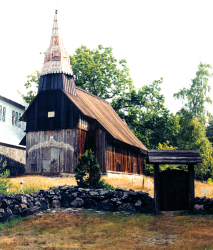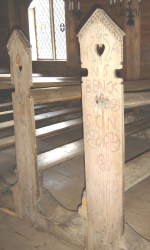Ruhnu Wooden Church 



Ruhnu Wooden Church, aka Ruhnu St. Magdalene Church, the oldest remaining wooden structure in Estonia. The wooden church was consecrated in 1644 and newly consecrated in 1999.
The original building constructed 1643–44 consisted of an oblong one-aisle nave and a narrower choir room with a polygonal end part and altar that joined the nave on the east. The originally unlined walls are hewed out of crossbeams, the roof out of boards. The western front hall with a baroque tower was probably built in 1755. There is a curving late-baroque wooden arch with acanthus and floral décor above the west portal; it is believed to have originally been a part of the stern of a ship that wrecked nearby. During the second half of the 19th century or perhaps already by 1851 a vestry was built on the northern side of the choir and both the inside and outside walls were covered with wooden lining.
The wooden altar with the lime stone altar slab, pulpit and some of the pews were made at the same time when the church building was finished. The nave has a curved wooden ceiling and in the west part of the room there is a narrow organ balcony (probably 1735) supported by two wooden pillars. A kneeling bench that surronds the altar is from 19th century (carvings on the front and southern side are from 17th–18th century). On the east wall of the choir room there is an old altar painting – “Christ in the Garden of Gethsemane” (mid-19th century).
On both sides of the middle walkway there are pews the outer ends of which are attached to the walls while the inner ends lean on quadrangular hewn beams along the walkway. The end boards of the southern (men’s’ side) pews are decorated with ornamental patterns and the owners’ names, initials and family seals. The end boards of the women’s side are lower and the decorations are simpler. The pews are mostly from 17th and 18th century, some from 19th century.
The painted glass panes of the lead frame windows (17th century) were taken to Sweden in 1944 and are located in Stockholm. The windows were restored and glass paintings were copied in 1998 in the glass department of the Estonian Academy of Arts.
The painting ‘Parade Portrait of Duke Wilhelm of Courland and Zemgale” (a 1895 copy of the 1615 original painting) is displayed at the church, so are Duke Wilhelm’s and Duchess Sophia’s coat of arms epitaphs (1615) and a coat of arms shaped name plate with an acanthus flange (1731) crafted by Johann Märtens, woodcarver from Ventspils.
Related articles
- Ruhnu St. Magdalene Church
- Ruhnu churchyard
- Ruhnu old chapels
- Stained glass windows in Ruhnu wooden church
Created in 2014






